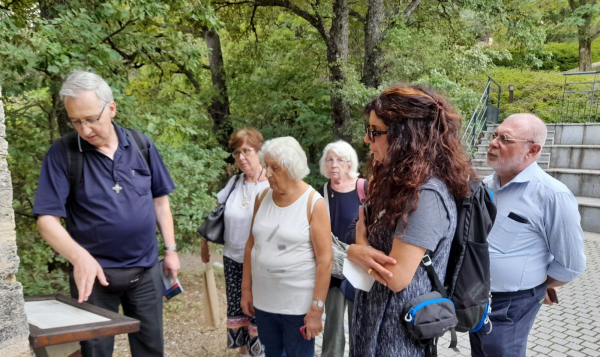I have wanted for many years to set in context Fr Eymard’s life, a story that I have known for more than 30 years by frequenting the SSS communities in Rome at the churches of the Canadian Martyrs and San Claudio in the Piazza San Silvestro, where I used to pray as a university student because they always had exposition of the Blessed Sacrament.
With great enthusiasm I signed up to join a Pilgrimage from 28 August to 3 September.
I shall focus particularly on four moments that profoundly marked my soul.
- The first of these was “the three crosses where the Chapel of the Calvary stood”. As a young boy Eymard used to climb towards that place barefooted in the middle of the cold and snow of winter, to prepare himself for communion. His spiritual childhood was characterised from an early stage by a strong penitential inclination to make expiation and reparation.
From an early age the thought of suffering was never far from his mind and heart; rather, he regarded the cross not as a punishment sent by God, but as a proof of love, which makes me appreciate Fr Eymard in a particular way and moves me with tenderness. What a beautiful spiritual pedagogy he expressed in these words: “Oh, how much I need to be in silence during these moments of suffering! … because I am not strong enough before the silence of the cross I need to pray, to be patient, to bless God.”
- Second important stop: the Eymard Chapel (the old parish church at La Mure), with the baptismal font where he received the sacrament of Baptism. I found myself praying with the rays of sun coming through the church’s beautiful windows with images of Fr Eymard’s life. In the solitude of that chapel I found myself to offer my sufferings, my family, recognising my weakness and my rebellion instead of praying, being patient and praising God the Father in front of trial.
- Another stage, the rock at Saint-Romans, where Fr Eymard as a young priest used to go to pray at the parish Calvary, set up in 1712, consisting of a Via Crucis and a chapel at the top of the rock, with three crosses that stand out and dominate the valley below. Here I was able to understand how one can get lost in the harmony of creation, in the beauty of nature that mirrors the divine masterpiece and how time is relative and may seem to stand still or pass quickly. As Fr Eymard found here the “mountain of love”, I discovered how it is possible to contemplate divine goodness and to see eagle’s wings lifting one up and raising one above so much human lowliness. Here I found another aspect of Fr Eymard: poetic, sensitive, and forward looking regarding the feminine world capable of launching pure and deep friendships with the sole scope of a reciprocal spiritual growth.
- Last stop, but first in my heart: the sanctuary of Our Lady of La Salette with its message of reparation, to which Fr Eymard responded without delay and received as one being eucharistic, salvific, reparational. I understood from all the steps in the pilgrimage that his life-teaching is to adore, to make reparation, intercede, give thanks, and serve with love, ever selflessly, unto the end of one’s own strength. But at the sanctuary of La Salette every fibre of my being felt as a part of a whole and I was entirely involved. The visual impact was impossible to describe because of its beauty, the Church built with dark stone and colourful windows and special paintings, the crucifix with images of the instruments of the Passion. All these together with the beauty of the mountain and a unique landscape, as unique as the Saint Peter-Julian Eymard chapel is for adoration, with the Blessed Sacrament always exposed and the icon of Our Lady of Tenderness welcoming and embracing one with all its sweetness.
I can state, without a doubt, that Fr Eymard made me discover how today it is so important for everyone, lay people and not, to turn off the computer, television, cell phone, give up meetings, assemblies and sterile talks and cast oneself at the feet of our Saviour, beside our Mother, in order to be able to disarm the just anger of heaven and save the world despite of itself.
I confess I prayed so that through the intercession of Fr Eymard there may be a flourishing of new and effective vocations not only in the Blessed Sacrament Congregation, that God may send workers because the harvest is plentiful, but I also prayed that the beauty and purity of Fr Eymard’s message may not be welcomed superficially or considered too old for our times that are more taken up by work than by worship.
Rita Alonzi

